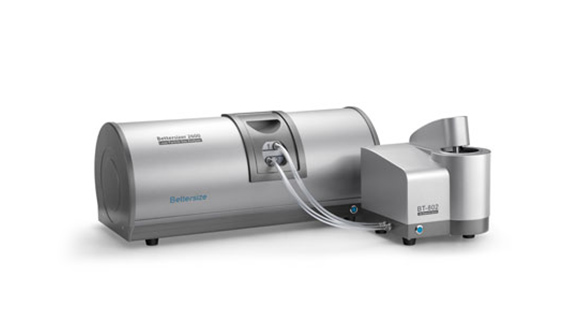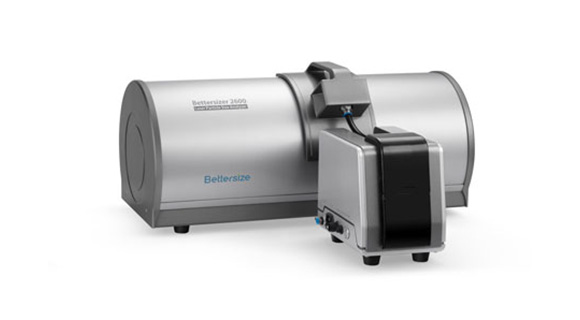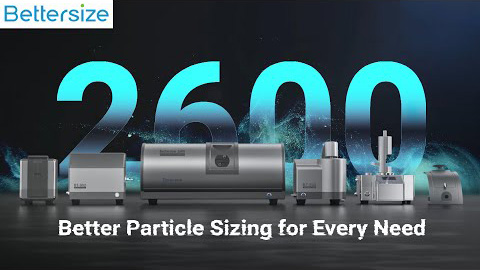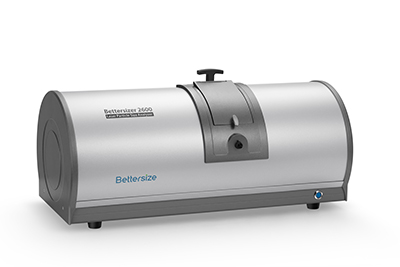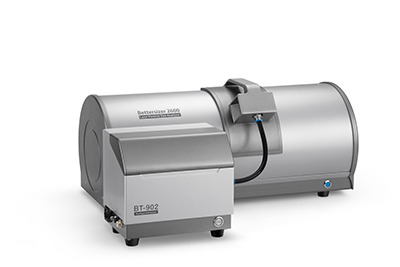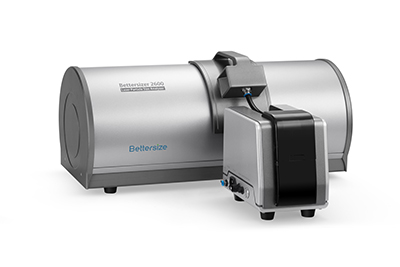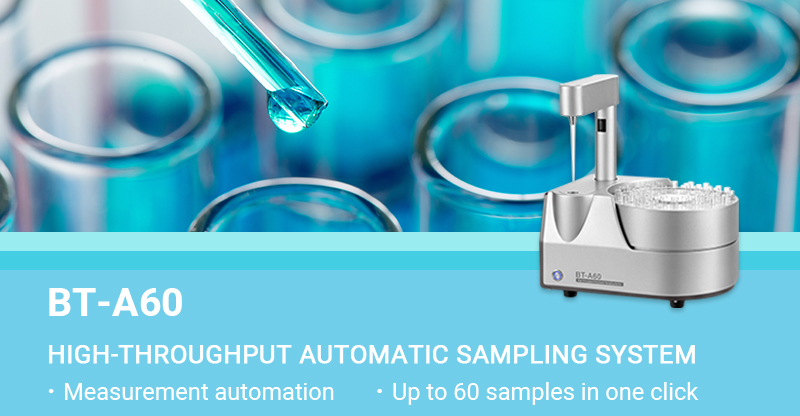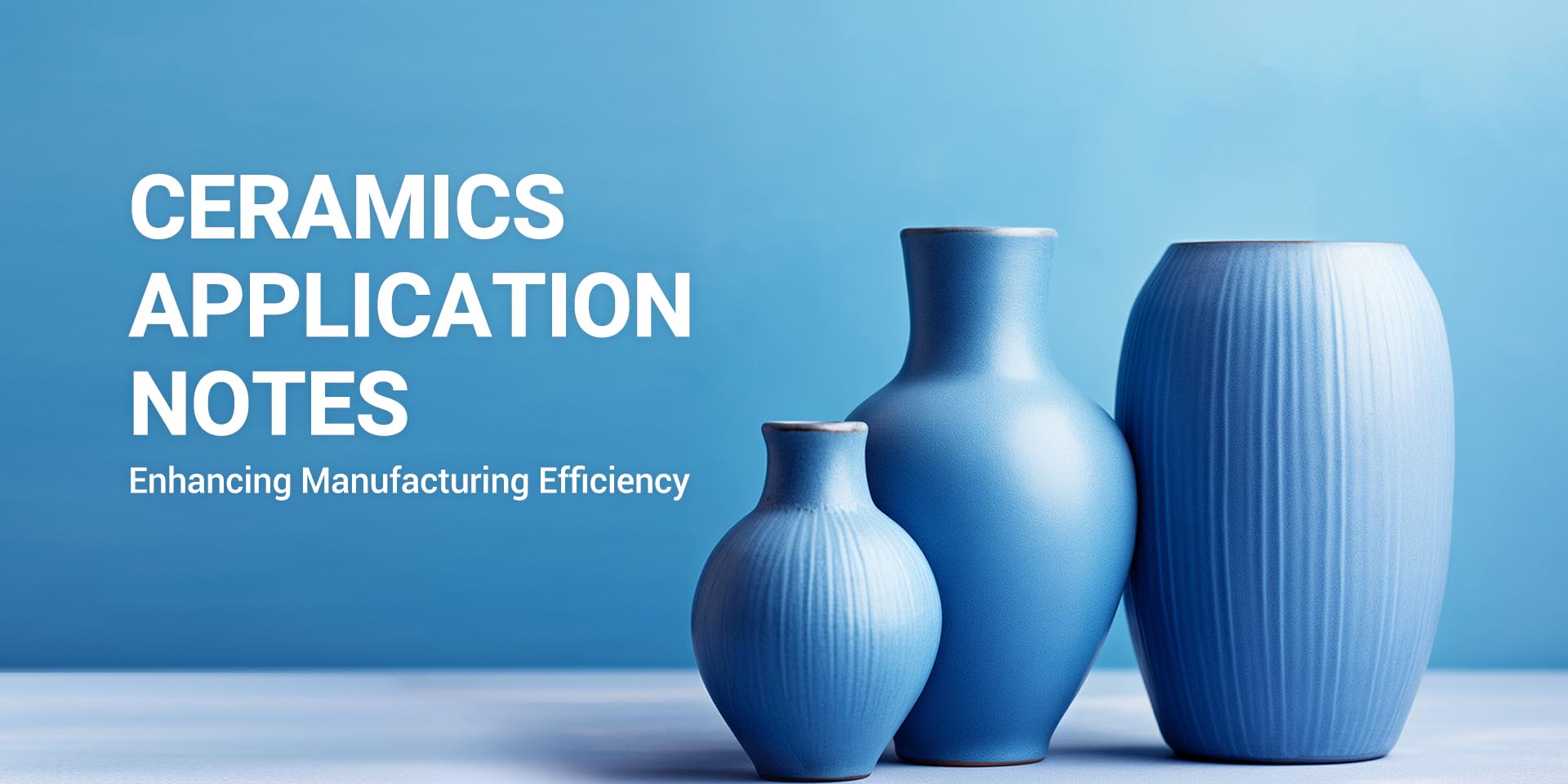Bettersizer 2600
La taille des particules peut être mesurée par la méthode humide ou sèche, en utilisant le Bettersizer 2600. Une variété d'applications ont été couvertes par cet analyseur polyvalent et puissant, avec sa conception modulaire et ses technologies brevetées. Les utilisateurs peuvent caractériser des matériaux de 0,02 μm à 2600 μm, facilement et avec précision.
Caractéristiques et avantages
- ● Technologie : Diffraction laser
- ● Gamme de taille des particules : Dispersion humide : 0,02 à 2 600μm Dispersion sèche : 0,1 à 2 600μm.
- ● La méthode de calibrage des particules par voie humide ou sèche convient à une grande variété de systèmes de particules dispersantes.
- ● Mesure précise des particules de petite et de grande taille couvrant la gamme la plus large grâce à une nouvelle technologie brevetée utilisant les systèmes optiques de Fourier et de Fourier inversé.
- ● Banc optique avec 92 détecteurs couvrant une plage angulaire de 0,016° - 165° Dispersion humide et/ou sèche en option
- ● Module de dispersion à sec de petit volume pour les petites quantités d'échantillons, en particulier pour les échantillons pharmaceutiques ou de valeur en quantité limitée
- ● Changement facile et rapide entre les modules de dispersion
- ● Facilité de mise en œuvre, création et utilisation de procédures opérationnelles standard pour les nouveaux matériaux
- ● Mesure de l'indice de réfraction afin d'obtenir un paramètre plus précis pour le calcul des résultats.
- ● Logiciel convivial, facile à apprendre
Vidéo
Bettersizer 2600 | Laser Diffraction Particle Size Analyzer (Wet & Dry) 
Snippet - How to Measure Particle Size of Coffee Powder 
How to Install and Operate Bettersizer 2600 
Ask an Expert! Introducing Bettersizer 2600 
A Brief Introduction to Laser Diffraction | Fundamentals of Bettersizer 2600 
Bettersizer 2600 Demonstration with Corundum (Al2O3) sample 
How to Measure Particle Size of Cosmetics 
How to Measure Particle Size of Coffee Powder 
Bettersizer 2600 Overview | Laser Diffraction Particle Size Analyzer (Dry & Wet Dispersions) 
Vue d'ensemble
1. Système optique de Fourier et de Fourier inverse
Le Bettersizer 2600 est supérieur dans la combinaison des conceptions de Fourier et de Fourier inverse. Cette conception intelligente permet, d'une part, la détection de la lumière diffusée dans une très large gamme angulaire allant de 0,016° à 165°. D'autre part, contrairement à la conception de Fourier inverse, les particules ne doivent pas nécessairement se trouver sur un seul plan, ce qui permet de mesurer simultanément avec précision les particules de petite et de grande taille.
Caractéristiques de la combinaison de la conception de Fourier et de la conception de Fourier inverse
- Réseau de détecteurs sphériques : Détecteurs avant, latéraux et arrière en 92 pièces au total ;
- Lentille de Fourier de très grande taille ;
- Faible encombrement : Conception compacte pour économiser de l'espace.

2. Logiciel intuitif et puissant
- Interface utilisateur intuitive et fonctionnement ordonné
- Courbe PSD en temps réel pour déterminer les conditions de mesure optimales
- Routine de mesure entièrement automatique
- Routine de nettoyage automatique
- Sauvegarde automatique des données et rapports hautement personnalisables
- Conversion directe selon les modèles d'évaluation de Fraunhofer et de Mie
- Passage d'un module de dispersion humide à un module de dispersion sèche en un seul clic
3. Dispersion humide
LeBT-802 est conçu pour la mesure de la taille des particules avec de l'eau comme milieu.


| éthanol | le méthanol | Isopropanol | éther |
| Toluène | Xylène | Dichlorométhane | Octane |
| Acétate d'éthyle | Acétone | Oléate de méthyle | Solvants NMP |
LeBT-80N est constitué d'une coque en acier inoxydable. Il comprend une pompe centrifuge, un disperseur ultrasonique, une canalisation en PTFE, une cellule d'échantillonnage en quartz fritté, un circuit de contrôle, etc.



LeBT-804 est conçu pour les mesures d'échantillons de grande valeur ou de faible volume, lorsque le milieu est un solvant ou de l'eau. Le module se compose d'une coque en ABS, d'un moteur d'agitation, d'une cuvette (8 ml), d'un agitateur, etc.
- Le volume maximal est de 8 ml pour une masse d'échantillon comprise entre 0,005 et 0,1 g.
- Convient aux échantillons dispersés dans l'eau ou dans une phase organique.
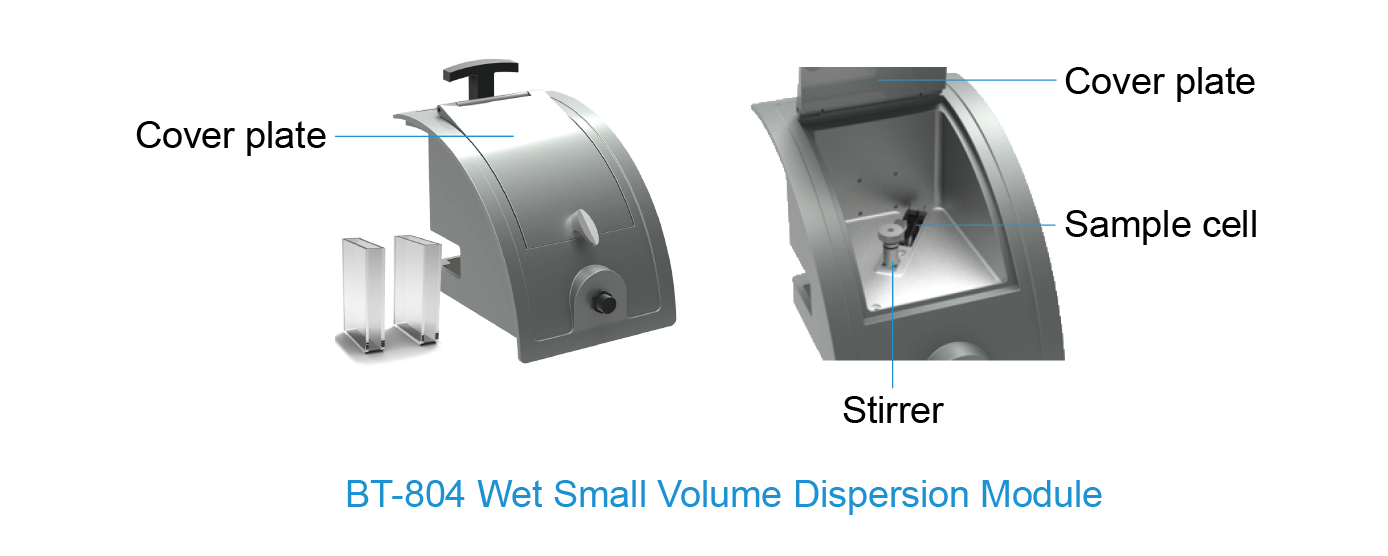

4. Dispersion à sec
LeBT-902 convient aux mesures de poudres sèches. Le gaz utilisé peut être de l'air comprimé, de l'azote ou d'autres gaz nobles.
LeBT-902 est composé d'un alimentateur vibrant électromagnétique, d'un tube venturi, d'un circuit de gaz, d'un circuit électrique, d'un capteur de pression, etc.




5. Applications

Citations
- Bettersizer 2600
Functional redundancy as an indicator for evaluating functional diversity of macrobenthos under the mussel raft farm near Gouqi Island
DOI: 10.1016/j.aquaculture.2023.740024 Read ArticleZhejiang Ocean University | 2024Biological traits analysis (BTA) helps to evaluate the effects of different environmental variables on the traits-based functional composition of macrobenthos. However, research on functional traits of macrobenthos under mussel farming is limited. We investigated the spatial and temporal response of the benthic system in terms of taxonomic and functional diversity to environmental variables of farming and natural stressors resulting from suspended mussel farming near Gouqi Island of eastern China Sea. The functional traits of macrobenthic assemblages under mussel farming were characterized by “medium adult body size”, “vermiform body form”, “high flexibility”, “infauna”, “semi-motile”, “gonochoristic”, “surface deposit-feeders”, “carnivores”, “semi-motile burrowers”, and “tube-dwellers”. Functional redundancy was stable in response to mussel farming stresses among seasons, whereas species diversity showed efficient to evaluate natural variables. Functional diversity was significantly affected by farming stressors rather than natural variables, Further analysis using multivariate methods together with continuous monitoring were highlighted to evaluate the impacts of mussel farming. Our results reinforce the importance of macrobenthic species and functional traits analysis to evaluate human stresses driven impacts in offshore ecosystems. By analysing the environmental variables with different sources, independently, we concluded the main effects of human pressures on macrobenthic community. Such distinction could be particularly effective to isolate variable environmental descriptors and evaluate their effects on functional diversity, making the current approach promising for the evaluation of ecological effects of anthropogenic stressors in aquaculture areas. - Bettersizer 2600
Degradation characteristics and utilization strategies of a covalent bonded resin-based solid amine during capturing CO2 from flue gas
DOI: 10.1016/j.seppur.2023.125621 Read ArticleChina University of Petroleum | 2024In this study, various types of degradation as well as attrition which are possibly encountered in a circulating fluidized bed temperature swing adsorption (CFB-TSA) process, were conducted experimentally to evaluate the stability of a resin-based solid amine sorbent. Other characterizations methods, such as elemental analysis (EA), Fourier transform infrared spectroscopy (FTIR) etc. were applied to further reveal the degradation mechanisms. The results showed that thermal degradation occurs from 140–160 °C due to the decomposition of amine group. The CO2-induced degradation occurs from a higher temperature of 160–180 °C accompanied by the production of urea. Hydrothermal stability is good below 130 °C, but the ionic impurities in steam crystalized on particle surface can accelerate the degradation. Oxidative degradation is the most harmful, which starts at a lower temperature of 70–80 °C with the formation of aldehyde. The existence of H2O in atmosphere can alleviate the oxidative and CO2-induced degradations. The employed sorbent has a very low attrition index of 0.05, which is 1–2 orders lower than typical commercial fluidized bed catalysts. Based on the results of stability evaluation, some design suggestions for proper utilization of this sorbent or other similar resin-based sorbents have been provided in an industrial CFB-TSA process.
- Bettersizer 2600
De-branching of starch molecules enhanced the complexation with chitosan and its potential utilization for delivering hydrophobic compounds
DOI: 10.1016/j.foodhyd.2023.109498 Read ArticleShihezi University | 2024The current study aimed to prepare the complexes between debranched-waxy corn starch and chitosan polymers (DBS-CS), and then investigated their corresponding structural characteristics, rheological property and potent application in Pickering emulsion. The results indicated that the existence of chitosan significantly inhibited starch short-range molecular rearrangement for all DBS-CS samples, which was manipulated by both debranching treatment and chitosan content. Interestingly, this is the first study to reveal that the outstanding peak at 1.8 ppm in 1H NMR spectrum for sample DBS-CS was gradually shifted towards a lower-field region following an increased chitosan content. Moreover, the debranching treatment shifted the crystallinity pattern from A-type to B-type and the relative crystallinity of DBS-CS decreased gradually with the increased content of CS. All samples had a pseudoplastic fluid and shear-thinning behavior with an enhanced shear resistance following the complexation. The DBS-CS was applied in a Pickering emulsion for showing a greater emulsifying stability and a lower gel strength than native NS-CS prepared emulsion. Importantly, the encapsulation ability of curcumin in the DBS-CS emulsion was significantly improved, followed by an increase of 15.45% for its corresponding bioavailability compared to the control. Therefore, this study might highlight a potential carrier for delivering the bioactive substances in a green pattern. - Bettersizer 2600
Heat-induced aggregation behavior of wheat gluten after adding citrus pectin with different esterification degree
DOI: 10.1016/j.foodhyd.2023.109420 Read ArticleGansu Agricultural University | 2024Wheat gluten aggregation during heat treatment is beneficial to the final quality of gluten-based products. Exogenous pectin can affect gluten aggregation. However, the effect of pectin with different degrees of esterification on the heat-induced aggregation behavior of gluten and its possible mechanism are still unclear. Thus, the heat-induced aggregation behavior of gluten after adding pectin with different esterification degree was studied in this study. When the temperature was raised from 25 °C to 95 °C, pectin affected gluten aggregation and was related to the degree of esterification. Specifically, the results of rheological properties and particle size indicated that low-ester pectin improved the viscoelasticity of gluten and promoted gluten aggregation. Thermal properties revealed that enthalpy of gluten added with low-ester pectin (37%) increased from 92.96 J/g to 95.40 J/g during heating process. Structurally, the fluorescence intensity and surface hydrophobicity of gluten added with low-ester pectin (37%) were lower than those added with high-ester pectin (73%). In addition, low-ester pectin (37%) significantly increased the disulfide bond content (from 15.31 μmol/g to 18.06 μmol/g) and maintained β-sheet content of gluten compared with gluten alone at 95 °C, indicating that low-ester pectin was more likely to induce gluten aggregation. However, scanning electron microscope showed that the gluten added with low-ester pectin (46%) exhibited a denser network structure at 95 °C than that added with low-ester pectin (37%). These results will provide a theoretical base for the regulation of gluten aggregation and the quality of gluten-based products by pectin with different esterification degree.
- 1
- 2
- 3
- 4
- 5
- 6
- 84
Ressources sélectionnées
Témoignages


Analyseur de taille de particules apparenté
-
BeScan Lab
Stability Analyzer
Particle size ranges from 10 nm to 1 mm
Volume fraction up to 95%
Compliance with ISO/TR 18811, 13097, 21357, 22107
-
Bettersizer S3 Plus
Particle Size and Shape Analyzer
Measurement range: 0.01 - 3,500μm (Laser System)
Measurement range: 2 - 3,500μm (Image System)
-
Bettersizer ST
One-stop Particle Size Analyzer
Dispersion type: Wet
Measurement range: 0.1 - 1,000µm
Repeatability: ≤1% variation
-
BT-Online1
Online Particle Size Analyzer
Dispersion type: Dry
Measurement range: 0.1 - 1,000μm
Accuracy: ≤1% (D50 of certified reference material)





